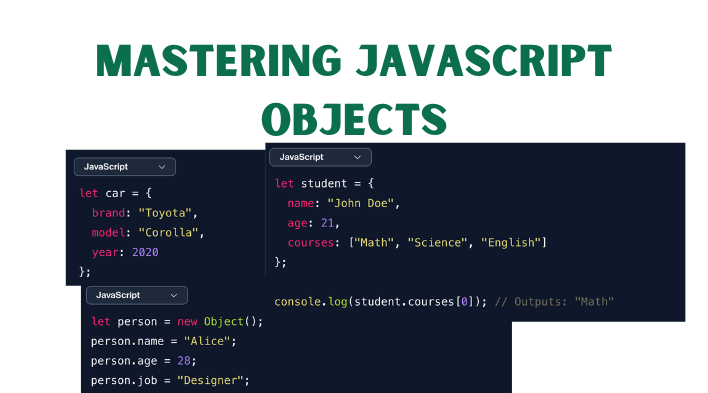Day 5: Mastering JavaScript Objects - A Core Skill for Software Engineers
 Stanley Owarieta
Stanley Owarieta
JavaScript objects are fundamental to how the language operates and are essential for writing efficient, scalable code. In today’s post, we’ll explore what JavaScript objects are, their role in software development, how to create them, the different types of objects, object methods, and the use of arrays within objects. We’ll also walk through some practical examples.
What Are JavaScript Objects?
In simple terms, a JavaScript object is a collection of key-value pairs. Unlike arrays, which use numerical indexes, objects use named keys (properties) to store and retrieve values. Think of objects as containers that hold related data and functions (called methods) about a specific entity.
Why Objects Are Important for Software Engineers
Objects are essential because they allow developers to model real-world entities, such as users, products, or events, in a structured way. They are incredibly flexible and provide the backbone for most modern software architectures, from frontend interfaces to backend APIs. Whether you're building web apps or managing large datasets, objects help you group data logically and manage it effectively.
How to Create JavaScript Objects
There are several ways to create an object in JavaScript, but the most common method is using object literals, where you define the properties and their values inside curly braces {}.
let car = {
brand: "Toyota",
model: "Corolla",
year: 2020
};
In this example, the
carobject has three properties:brand,model, andyear.
You can also use the new Object() constructor, although object literals are preferred for simplicity:
let person = new Object();
person.name = "Alice";
person.age = 28;
person.job = "Designer";
Types of JavaScript Objects
In JavaScript, objects can be classified into different types based on their structure and purpose:
Plain Objects: These are the most basic type of objects and are created using the object literal notation or the
new Object()constructor.Function Objects: Functions in JavaScript are also objects. They can have properties and methods just like other objects.
Array Objects: Arrays are technically a type of object, and they come with their own set of methods like
push(),pop(), andfilter().Built-in Objects: JavaScript comes with several built-in objects, such as
Date,Math, andRegExp, each providing specialized functionality.
JavaScript Object Methods
Objects in JavaScript can have methods, which are functions that operate on the data stored in the object. Here are a few essential object methods every developer should know:
Object.keys(): Returns an array of an object’s property names.
Object.values(): Returns an array of an object’s values.
Object.entries(): Returns an array of an object’s key-value pairs.
hasOwnProperty(): Checks if an object has a specific property.
Object.assign(): Copies properties from one or more objects into a target object.
Example:
let user = {
username: "Stanley24",
email: "stanley@example.com",
age: 25
};
let keys = Object.keys(user); // ["username", "email", "age"]
let values = Object.values(user); // ["Stanley24", "stanley@example.com", 25]
Arrays in JavaScript Objects
You can also store arrays within objects to handle collections of related data. For example, an object representing a student could have an array of courses:
let student = {
name: "John Doe",
age: 21,
courses: ["Math", "Science", "English"]
};
console.log(student.courses[0]); // Outputs: "Math"
Arrays in objects are especially useful when you need to represent multiple items related to a single entity.
Example of JavaScript Object Code
Let’s bring everything together with a practical example. Below is a sample code of a JavaScript object that contains properties, an array, and methods:
let library = {
name: "City Library",
location: "Downtown",
books: ["1984", "Brave New World", "The Catcher in the Rye"],
displayBooks: function() {
console.log("Available books: " + this.books.join(", "));
},
addBook: function(newBook) {
this.books.push(newBook);
console.log(`${newBook} has been added to the library.`);
}
};
// Accessing properties
console.log(library.name); // Outputs: City Library
// Calling methods
library.displayBooks();
// Outputs: Available books: 1984, Brave New World, The Catcher in the Rye
library.addBook("To Kill a Mockingbird");
// Outputs: To Kill a Mockingbird has been added to the library.
In this example, we have:
A
libraryobject with properties likename,location, andbooks.A method
displayBooks()to list all the books.A method
addBook()to add a new book to thebooksarray.
Learn More: Free JavaScript Resources
If you're interested in deepening your understanding of JavaScript objects and other JavaScript concepts, check out these free resources:
JavaScript Object Tutorial - W3Schools: A comprehensive guide on JavaScript objects, covering everything from basics to advanced topics.
Mozilla Developer Network (MDN) Web Docs - JavaScript Objects: Detailed documentation on JavaScript objects with explanations and examples.
FreeCodeCamp - JavaScript Object-Oriented Programming: A free interactive learning platform that offers lessons on JavaScript objects and other coding concepts.
Codecademy - Learn JavaScript: Another interactive platform that provides a free JavaScript course, including modules on object-oriented programming.
These resources can help you gain a deeper understanding of how to work with JavaScript objects and improve your coding skills.
Links
To learn more about JavaScript Objects and methods, visit our previous blog post on Understanding JavaScript Functions.
To learn more about JavaScript Objects and methods, visit our previous blog post on Arrays in JavaScript: Methods and Best Practices.
Subscribe to my newsletter
Read articles from Stanley Owarieta directly inside your inbox. Subscribe to the newsletter, and don't miss out.
Written by

Stanley Owarieta
Stanley Owarieta
I help tech businesses and startups create engaging, SEO-driven content that attracts readers and converts them into customers. From in-depth blog posts to product reviews, I ensure every content is well-researched, easy to understand, and impactful. As a programming learner with HTML, CSS, and JavaScript knowledge, I bring a unique technical perspective to my writing. If you're looking for content that ranks and resonates, let's connect! 📩 Open to collaborations! Message me or email me at freelance@stanleyowarieta.com